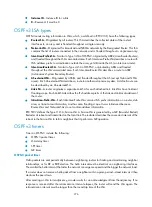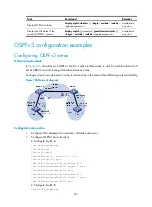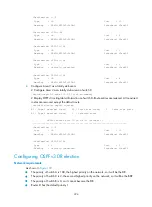
281
Step Command
Remarks
2.
Enter interface view.
interface
interface-type
interface-number
N/A
3.
Configure a network type for
the OSPFv3 interface.
ospfv3 network-type
{
broadcast
|
nbma
|
p2mp
[
non-broadcast
] |
p2p
} [
instance
instance-id
]
Optional.
The network type of an interface
depends on the media type of the
interface.
Configuring an NBMA or P2MP neighbor
For NBMA and P2MP interfaces (only when in unicast mode), specify the link-local IP addresses of their
neighbors because these interfaces cannot find neighbors through broadcasting hello packets. You can
also specify DR priorities for neighbors.
To configure an NBMA or P2MP (unicast) neighbor and its DR priority:
Step Command
1.
Enter system view.
system-view
2.
Enter interface view.
interface
interface-type interface-number
3.
Specify an NBMA or P2MP
(unicast) neighbor and its
DR priority.
ospfv3 peer
ipv6-address
[
dr-priority
dr-priority
]
[
instance
instance-id
]
Configuring OSPFv3 routing information control
This section describes how to configure the control of OSPF routing information advertisement and
reception, and redistribution from other protocols.
Configuration prerequisites
Before you configure OSPFv3 routing information control, complete the following tasks:
•
Enable IPv6 packet forwarding.
•
Configure OSPFv3 basic functions.
Configuring OSPFv3 route summarization
If contiguous network segments exist in an area, use the
abr-summary
command to summarize them into
one network segment on the ABR. The ABR will advertise only the summary route. Any LSA in the
specified network segment will not be advertised, reducing the LSDB size in other areas.
To configure route summarization:
Step Command
Remarks
1.
Enter system view.
system-view
N/A
2.
Enter OSPFv3 view.
ospfv3
[
process-id
]
N/A
3.
Enter OSPFv3 area view.
area
area-id
N/A
















































